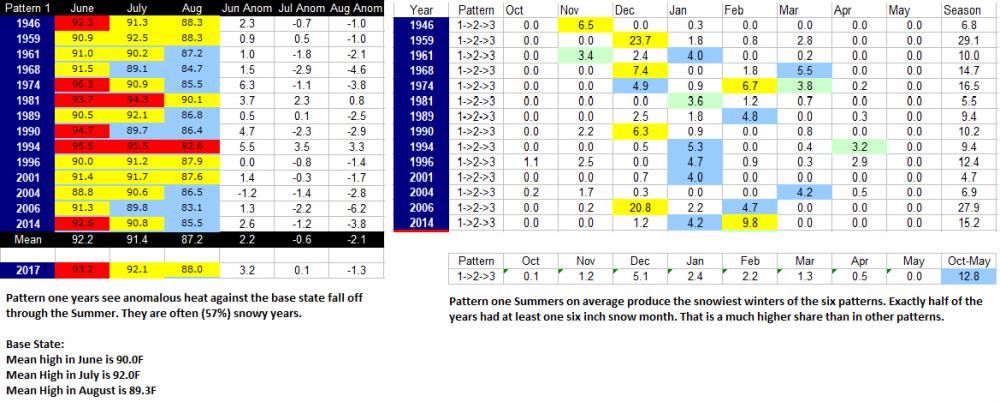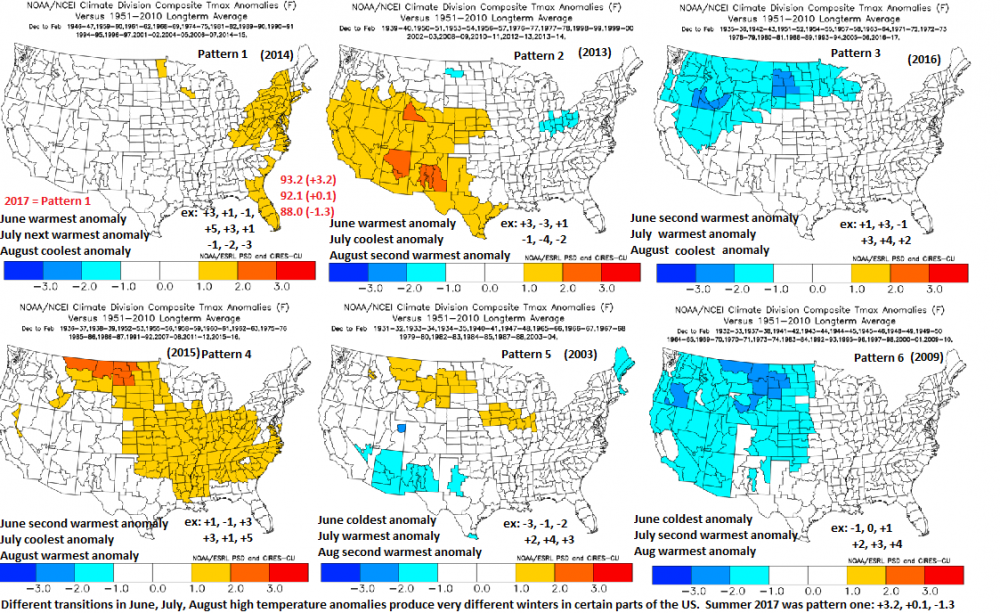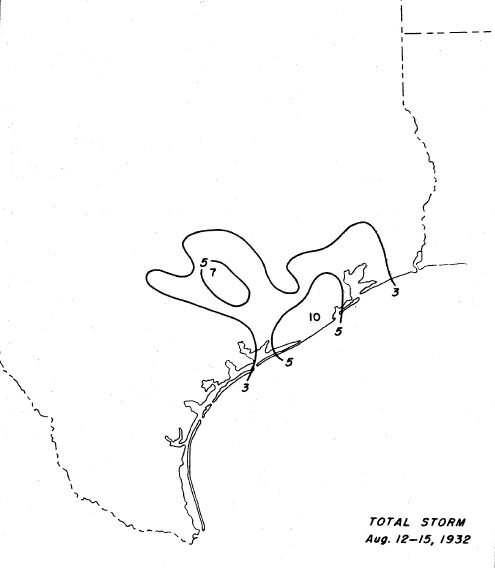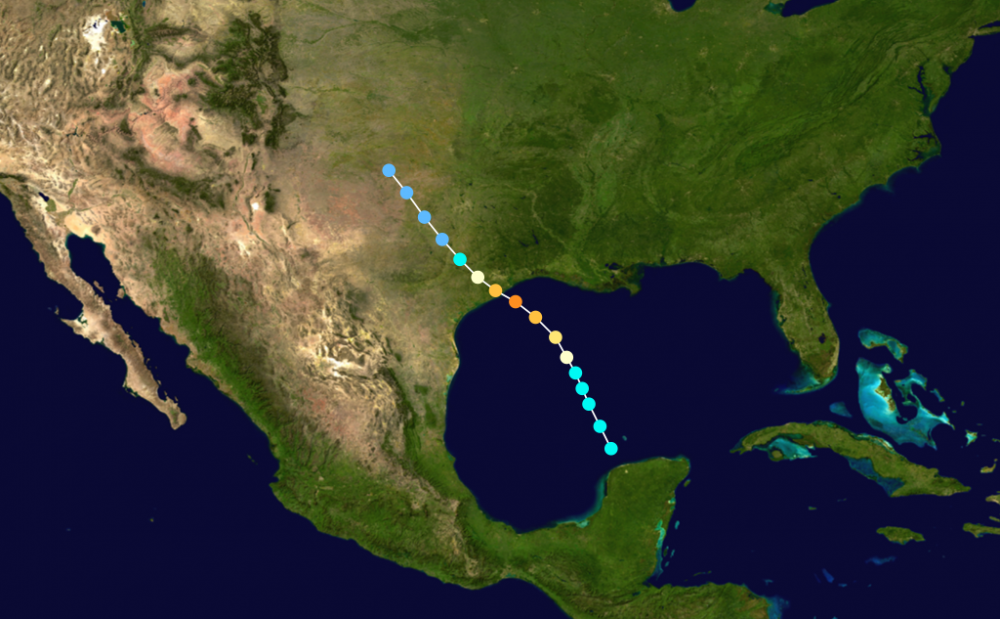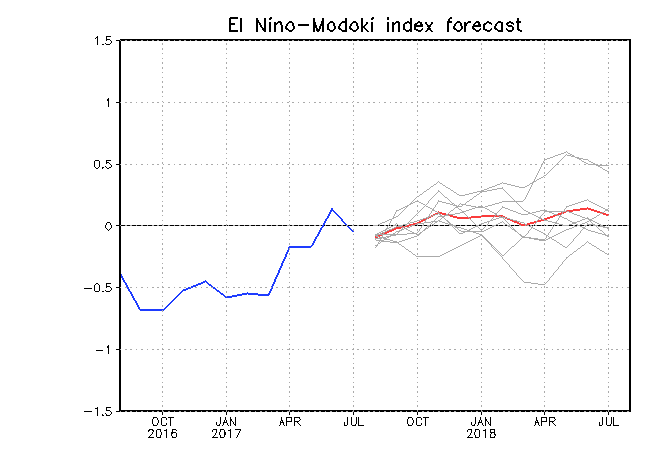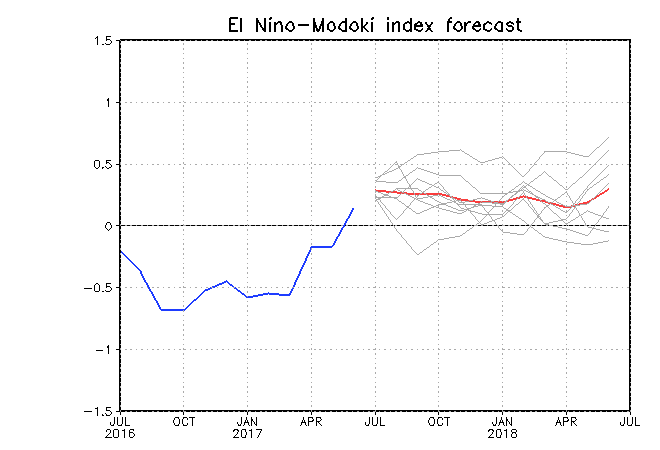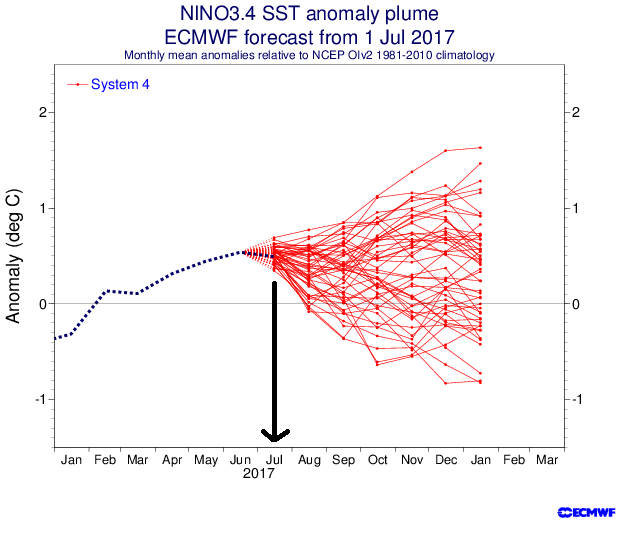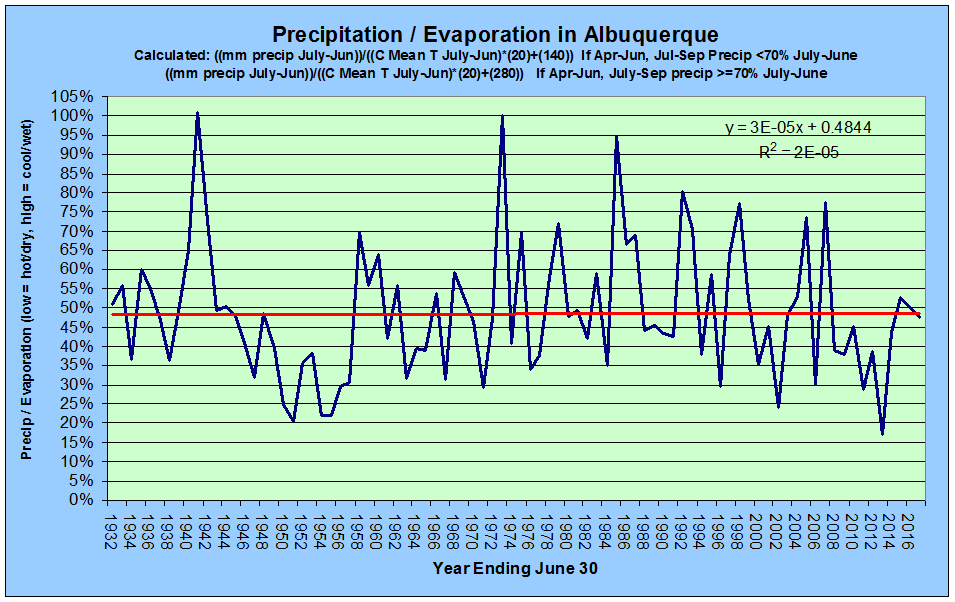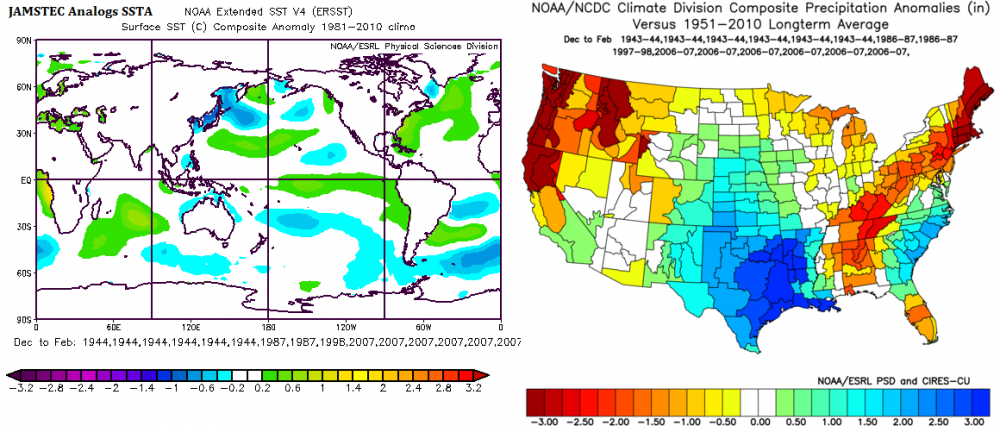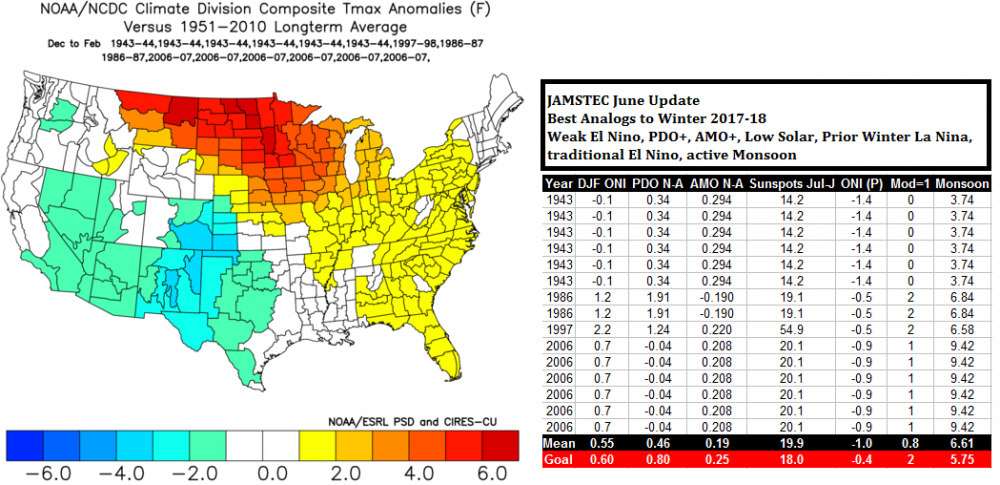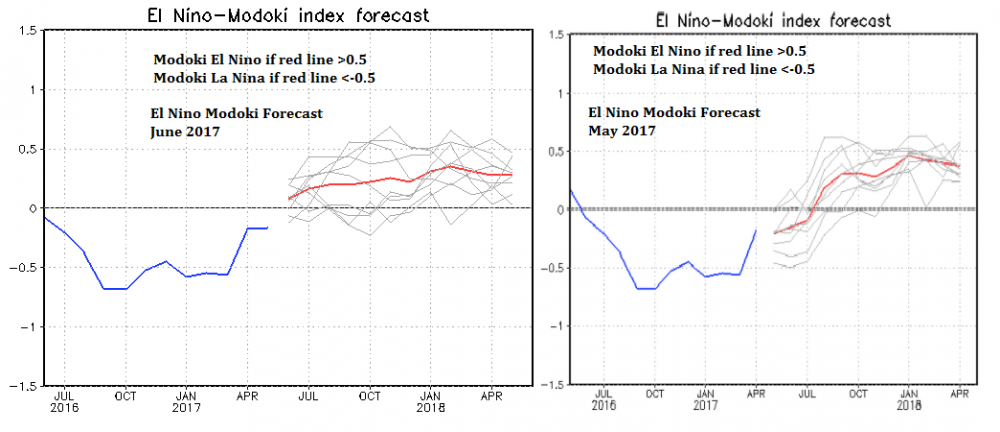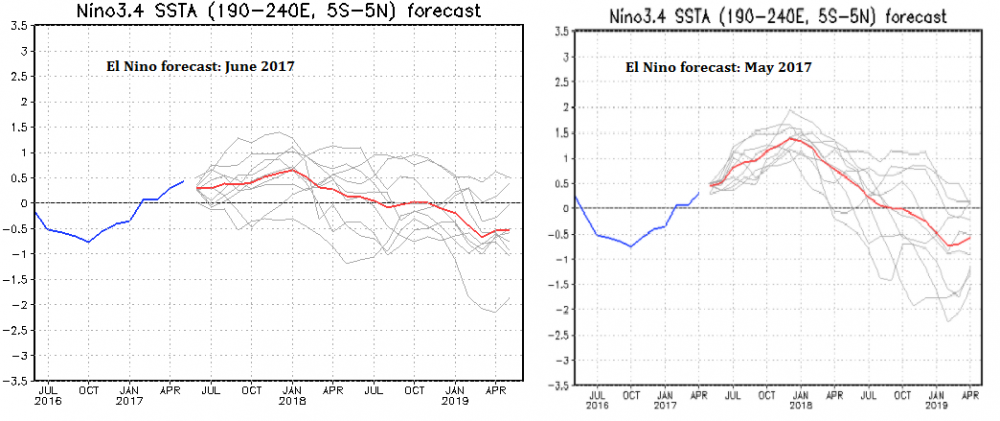
raindancewx
Members-
Posts
3,757 -
Joined
-
Last visited
Content Type
Profiles
Blogs
Forums
American Weather
Media Demo
Store
Gallery
Everything posted by raindancewx
-
MO/KS/AR/OK 2019-2020 Winter Wonderland Discussion
raindancewx replied to JoMo's topic in Central/Western States
I'm not a fan of 1999-00 for this winter, but I do like 2007-08 somewhat - look at how much closer 2007 is to 2017. Look at Summer 1999 - super cold in the SW, really most of the West, and super warm in the NE. It's almost the exact opposite of recent conditions. Part of that is we had pseduo-El Nino conditions in Apr-July, but still. I know there is a guy on the Accuweather forums who likes 1999-00, but he keeps insisting 1998-99 was a good match to last year even though the precip pattern was the complete opposite - for most of the West (NW dry not Wet, SW wet not dry, especially CA) and the South. -
Pretty sure it will be warm in Louisiana for the winter, but a lot cooler than last winter. None of that +6F to +8F garbage like last year. Maybe +1 to +3F? I have to re-do my simulations with the heavy rain we've gotten in TX/NM lately. The soil moisture does seem to impact the placement of the highs some. I think effectively there is something of a wake in zone where the sub tropical high will be because of Harvey, Irma, Jose, Katia, and Maria beating the day lights out of it and upwelling some colder ocean temperatures. My area is colder (not actually, you know cold) in La Nina winters that follow relatively long duration periods of heat. We've had (at least) 96 days 87F or higher, that tends to lead to near normal temperatures here. My area is colder (not actually cold) in La Nina winters when the Atlantic is cooler. My area also has exceptionally variable winters near the solar minimum - record heat / record cold are all near the minimum. Barring a complete bust over the next two days for highs, these years were the objective analogs that popped up for winter based on my Summer conditions - its heavily weighted to temps and preicp with low weight to ENSO. This is one method I use to look at winter - I'll give it some weight, but it isn't my forecast. The big big wild card for the winter especially late is if Mount Agung or one of these other suddenly active Ring of Fire volcanoes is going to erupt in a big way soon enough to screw up the Earth's heat intake.
-
I've had at least 0.64" rain today, one of the biggest precipitation days of the year here. Basically 48-50F from 6 pm to 9 pm with steady rain. Feels great actually. I had a wet September in my Summer outlook (from mid-May). Looks pretty good now if the NAM is right about the city getting another 0.6"-1.2" rain by Sept 30. I think I had 1.25", and we're at 0.74" right now. The link has the newest NAM outlook through 9/30/17. https://pbs.twimg.com/media/DKx3ktNU8AE9-V2.jpg:large Will be issuing my winter outlook (snow and DJF temps) sometime between Oct 7 - 15. I'll link it on here if anyone is curious.
-
What kind of recovery would see in the ice if Agung erupts at a similar magnitude to 1963? It was a VEI 5 eruption at around 8 degrees away from the equator. I know my coldest winter in 120+ years was 1963-64. Lots of evacuations in Bali right now.
-
Am I crazy for thinking we might be entering a Dustbowl redux? Last winter (2016-17) was very similar to 1931-32 by temperature anomalies nationally. This (2017) Hurricane season is the only one since 1850, other than 1932 - to have a category four hurricane hit Florida, Texas and Puerto Rico in the same season. The PDO, Nino 3.4 (raw) temperatures, AMO (raw) temperatures, and solar activity are all almost identical to 1932 right now. To me, the Dustbowl started after how dry / warm the 1932-33 winter was for much of the Midwest. PDO: Aug 1932: -0.1. Aug 2017: +0.1 AMO: Aug 1932: 23.51C, Aug 2017: 23.66C Sunspots July-June: 1932-33: 14.5 July-June 2017-18: 18.0? Other: Both years two years after Super (Modoki) El Ninos: 1930/2015 Look at how close Nino 3.4 is for August 2017 & August 1932 too - https://pbs.twimg.com/media/DKS8WhyVAAAb3KN.jpg:large
-
Negative NAO Winter
raindancewx replied to AfewUniversesBelowNormal's topic in Weather Forecasting and Discussion
NAO was +0.5 in 2016-17 for Nov-Mar according to this - http://www.cpc.ncep.noaa.gov/products/precip/CWlink/pna/norm.nao.monthly.b5001.current.ascii.table AO was very negative in Nov 2016 from what I remember, so thought maybe he meant that? But it ended up positive in Nov 2016 - Mar 2017 too. http://www.cpc.ncep.noaa.gov/products/precip/CWlink/daily_ao_index/monthly.ao.index.b50.current.ascii.table Jan Feb Mar Apr May Jun Jul Aug Sep Oct Nov Dec Nov-Mar 1950 0.92 0.40 -0.36 0.73 -0.59 -0.06 -1.26 -0.05 0.25 0.85 -1.26 -1.02 -0.504 1951 0.08 0.70 -1.02 -0.22 -0.59 -1.64 1.37 -0.22 -1.36 1.87 -0.39 1.32 -0.092 1952 0.93 -0.83 -1.49 1.01 -1.12 -0.40 -0.09 -0.28 -0.54 -0.73 -1.13 -0.43 -0.352 1953 0.33 -0.49 -0.04 -1.67 -0.66 1.09 0.40 -0.71 -0.35 1.32 1.04 -0.47 0.17 1954 0.37 0.74 -0.83 1.34 -0.09 -0.25 -0.60 -1.90 -0.44 0.60 0.40 0.69 -0.48 1955 -1.84 -1.12 -0.53 -0.42 -0.34 -1.10 1.76 1.07 0.32 -1.47 -1.29 0.17 -0.502 1956 -0.22 -1.12 -0.05 -1.06 2.21 0.10 -0.75 -1.37 0.24 0.88 0.51 0.10 0.102 1957 1.05 0.11 -1.26 0.49 -0.79 -0.72 -1.19 -0.55 -1.66 1.32 0.73 0.12 -0.542 1958 -0.54 -1.06 -1.96 0.37 -0.24 -1.38 -1.73 -1.56 -0.07 0.16 1.64 -0.70 0.12 1959 -0.87 0.68 -0.15 0.36 0.39 0.40 0.74 0.06 0.88 0.89 0.41 0.44 -0.566 1960 -1.29 -1.89 -0.50 1.36 0.45 -0.21 0.35 -1.40 0.39 -1.73 -0.51 0.06 0.192 1961 0.41 0.45 0.55 -1.55 -0.36 0.86 -0.39 0.90 1.24 0.51 -0.62 -1.48 -0.682 1962 0.61 0.55 -2.47 0.99 -0.10 0.16 -2.47 0.14 -0.37 0.41 -0.23 -1.32 -1.012 1963 -2.12 -0.96 -0.43 -1.35 2.16 -0.43 -0.77 -0.64 1.79 0.94 -1.27 -1.92 -1.354 1964 -0.95 -1.43 -1.20 0.36 0.52 1.29 1.90 -1.77 0.20 0.74 -0.01 -0.15 -0.668 1965 -0.12 -1.55 -1.51 0.72 -0.62 0.29 0.32 0.45 0.37 0.38 -1.66 1.37 -0.572 1966 -1.74 -1.39 0.56 -0.75 0.22 1.05 0.32 -1.76 -0.45 -0.68 -0.04 0.72 0.298 1967 -0.89 0.19 1.51 0.18 -0.99 1.40 0.41 1.44 0.93 0.07 0.60 -0.45 -0.122 1968 0.13 -1.29 0.40 -1.08 -1.76 0.33 -0.80 -0.66 -1.92 -2.30 -0.93 -1.40 -1.254 1969 -0.83 -1.55 -1.56 1.53 0.55 0.55 0.57 -1.45 2.07 0.66 -0.96 -0.28 -0.612 1970 -1.50 0.64 -0.96 -1.30 1.14 1.55 0.10 0.10 -0.09 -0.92 -0.60 -1.20 -0.706 1971 -1.13 0.24 -0.84 -0.24 0.50 -1.57 0.24 1.55 0.39 0.58 -0.20 0.60 0.342 1972 0.27 0.32 0.72 -0.22 0.95 0.88 0.18 1.32 -0.12 1.09 0.54 0.19 0.384 1973 0.04 0.85 0.30 -0.54 -0.44 0.39 0.57 -0.06 -0.30 -1.24 -0.93 0.32 0.112 1974 1.34 -0.14 -0.03 0.51 -0.24 -0.14 -0.76 -0.64 0.82 0.49 -0.54 1.50 0.062 1975 0.58 -0.62 -0.61 -1.60 -0.52 -0.84 1.55 -0.26 1.56 -0.54 0.41 0.00 0.368 1976 -0.25 0.93 0.75 0.26 0.96 0.80 -0.32 1.92 -1.29 -0.08 0.17 -1.60 -0.754 1977 -1.04 -0.49 -0.81 0.65 -0.86 -0.57 -0.45 -0.28 0.37 0.52 -0.07 -1.00 -0.382 1978 0.66 -2.20 0.70 -1.17 1.08 1.38 -1.14 0.64 0.46 1.93 3.04 -1.57 0.04 1979 -1.38 -0.67 0.78 -1.71 -1.03 1.60 0.83 0.96 1.01 -0.30 0.53 1.00 0.104 1980 -0.75 0.05 -0.31 1.29 -1.50 -0.37 -0.42 -2.24 0.66 -1.77 -0.37 0.78 0.102 1981 0.37 0.92 -1.19 0.36 0.20 -0.45 0.05 0.39 -1.45 -1.35 -0.38 -0.02 0.202 1982 -0.89 1.15 1.15 0.10 -0.53 -1.63 1.15 0.26 1.76 -0.74 1.60 1.78 1.078 1983 1.59 -0.53 0.95 -0.85 -0.07 0.99 1.19 1.61 -1.12 0.65 -0.98 0.29 0.264 1984 1.66 0.72 -0.37 -0.28 0.54 -0.42 -0.07 1.15 0.17 -0.07 -0.06 0.00 -0.392 1985 -1.61 -0.49 0.20 0.32 -0.49 -0.80 1.22 -0.48 -0.52 0.90 -0.67 0.22 0.274 1986 1.11 -1.00 1.71 -0.59 0.85 1.22 0.12 -1.09 -1.12 1.55 2.29 0.99 0.308 1987 -1.15 -0.73 0.14 2.00 0.98 -1.82 0.52 -0.83 -1.22 0.14 0.18 0.32 0.422 1988 1.02 0.76 -0.17 -1.17 0.63 0.88 -0.35 0.04 -0.99 -1.08 -0.34 0.61 1.058 1989 1.17 2.00 1.85 0.28 1.38 -0.27 0.97 0.01 2.05 -0.03 0.16 -1.15 0.584 1990 1.04 1.41 1.46 2.00 -1.53 -0.02 0.53 0.97 1.06 0.23 -0.24 0.22 0.336 1991 0.86 1.04 -0.20 0.29 0.08 -0.82 -0.49 1.23 0.48 -0.19 0.48 0.46 0.55 1992 -0.13 1.07 0.87 1.86 2.63 0.20 0.16 0.85 -0.44 -1.76 1.19 0.47 0.886 1993 1.60 0.50 0.67 0.97 -0.78 -0.59 -3.18 0.12 -0.57 -0.71 2.56 1.56 1.376 1994 1.04 0.46 1.26 1.14 -0.57 1.52 1.31 0.38 -1.32 -0.97 0.64 2.02 1.196 1995 0.93 1.14 1.25 -0.85 -1.49 0.13 -0.22 0.69 0.31 0.19 -1.38 -1.67 -0.696 1996 -0.12 -0.07 -0.24 -0.17 -1.06 0.56 0.67 1.02 -0.86 -0.33 -0.56 -1.41 0.14 1997 -0.49 1.70 1.46 -1.02 -0.28 -1.47 0.34 0.83 0.61 -1.70 -0.90 -0.96 -0.142 1998 0.39 -0.11 0.87 -0.68 -1.32 -2.72 -0.48 -0.02 -2.00 -0.29 -0.28 0.87 0.376 1999 0.77 0.29 0.23 -0.95 0.92 1.12 -0.90 0.39 0.36 0.20 0.65 1.61 1.066 2000 0.60 1.70 0.77 -0.03 1.58 -0.03 -1.03 -0.29 -0.21 0.92 -0.92 -0.58 -0.412 2001 0.25 0.45 -1.26 0.00 -0.02 -0.20 -0.25 -0.07 -0.65 -0.24 0.63 -0.83 0.406 2002 0.44 1.10 0.69 1.18 -0.22 0.38 0.62 0.38 -0.70 -2.28 -0.18 -0.94 -0.004 2003 0.16 0.62 0.32 -0.18 0.01 -0.07 0.13 -0.07 0.01 -1.26 0.86 0.64 0.418 2004 -0.29 -0.14 1.02 1.15 0.19 -0.89 1.13 -0.48 0.38 -1.10 0.73 1.21 0.314 2005 1.52 -0.06 -1.83 -0.30 -1.25 -0.05 -0.51 0.37 0.63 -0.98 -0.31 -0.44 -0.254 2006 1.27 -0.51 -1.28 1.24 -1.14 0.84 0.90 -1.73 -1.62 -2.24 0.44 1.34 0.594 2007 0.22 -0.47 1.44 0.17 0.66 -1.31 -0.58 -0.14 0.72 0.45 0.58 0.34 0.524 2008 0.89 0.73 0.08 -1.07 -1.73 -1.39 -1.27 -1.16 1.02 -0.04 -0.32 -0.28 0.004 2009 -0.01 0.06 0.57 -0.20 1.68 -1.21 -2.15 -0.19 1.51 -1.03 -0.02 -1.93 -1.184 2010 -1.11 -1.98 -0.88 -0.72 -1.49 -0.82 -0.42 -1.22 -0.79 -0.93 -1.62 -1.85 -0.608 2011 -0.88 0.70 0.61 2.48 -0.06 -1.28 -1.51 -1.35 0.54 0.39 1.36 2.52 1.348 2012 1.17 0.42 1.27 0.47 -0.91 -2.53 -1.32 -0.98 -0.59 -2.06 -0.58 0.17 -0.424 2013 0.35 -0.45 -1.61 0.69 0.57 0.52 0.67 0.97 0.24 -1.28 0.90 0.95 0.856 2014 0.29 1.34 0.80 0.31 -0.92 -0.97 0.18 -1.68 1.62 -1.27 0.68 1.86 1.42 2015 1.79 1.32 1.45 0.73 0.15 -0.07 -3.18 -0.76 -0.65 0.44 1.74 2.24 1.282 2016 0.12 1.58 0.73 0.38 -0.77 -0.43 -1.76 -1.65 0.61 0.41 -0.16 0.48 0.508 2017 0.48 1.00 0.74 1.73 -1.91 0.05 1.26 -1.10 Nov-Mar NAO 2005-06: Negative 2006-07: Positive 2007-08: Positive 2008-09: Neutral 2009-10: Negative 2010-11: Negative 2011-12: Positive 2012-13: Neutral / Negative 2013-14: Positive 2014-15: Positive 2015-16: Positive 2016-17: Positive -
As mentioned earlier in this topic, its interesting seeing the ice extent coming back a bit with the AMO dropping a lot from last year. Came in at 0.314 in Sept 2017, down from 0.461(!) last September. We've caught 2008, and are running ahead of 2007, 2012, 2015, 2016 for sea ice extent on 9.11. We may catch 2010 or another year for lowest extent if there aren't more big losses soon. https://pbs.twimg.com/media/DJkbUBAU8AAmg72.jpg:large
-
The transition in mean highs in Jun->Jul->Aug is a pretty decent indicator of snow in ABQ. We had pattern one this Summer. Against 1931-2016 mean highs, June was +3.2, July was +0.1, and August was -1.3F. Historically, going from warmer to cooler anomalies from June to July to August tends to come before a snowy winter in Albuquerque. It isn't particularly biased by El Nino either, only 35% of the years that fit the pattern are El Nino. Most are actually Neutrals (58%), which is what I expect this year to be. Pattern one Summers also tend to have slightly warmer than normal winter highs in the Northeast, even with 2014-15 in there as a striking counter-example.
-
NSIDC has sea ice extent on 8/29/17 higher than 2007, 2011, 2012, 2015, 2016. Outside chance the lowest extent date ends up above 2008 too?
-
Had a lovely cloudy/cool day yesterday here, 76F for the high 60F at night. 78F or 79F today? https://t.co/on5O30hu92 Fall Outlook Anyway - Jamstec August update is in. Still likes a Neutral winter (but it uses a weird base period 1983-2006), and it has the West pretty cold now. Modoki values in winter are correlated somewhat with low solar, so I think its on the right track in dropping the Modoki value to 0, maybe to below 0 next month. >0 means Central Tropical Pacific is warmer than East/West Tropical Pacific. <0 means the opposite. So high Modoki values (>0 ) are a La Nina Traditional or El Nino Modoki signature (2009), while low values (<0) are a La Nina Modoki or El Nino Traditional signature. It does get weird, because just about La Ninas are -Modoki values, so -0.3 might be a better indicator. The +/-0 works well for El Ninos though. Last winter (DJF) was a La Nina Modoki, with -0.4C officially in DJF (after several -0.8C and -0.7C periods), with a -0.5 Modoki reading. I'm rooting for a -0.0 to -0.2 Modoki reading and a cold Neutral (-0.2 to -0.4C) ONI at this point. JAMSTEC had -0.2C in Aug 2016 for DJF 2016-17, but ended up at -0.4C. It shows +0.1C for DJF 17-18. So hopefully we stay in the negative Neutral zone. I like -0.3C or so for winter, maybe -0.5C in the Fall for one period.
-
I'll put my Fall Outlook on here tomorrow - it's fairly short, only 14 slides, 8 pictures. Generally, expecting a cooler Fall in New Mexico. We had a warm (+2.2), wet (+20%) Fall last year against 1931-2016 means. This year, expecting a cooler (-0.8F), wet (+30%) Fall against 1931-2016 means. Main differences for NM that I expect are: - Cooler/ Wetter Sept v. 2016 - Much Cooler (-6F, 69.9F instead of 75.9F) / Wetter Oct v. 2016 - Slightly Cooler / Much Drier Nov v 2016 - we had near record precip last November.
-
I've been playing with a Fall outlook by matching weather conditions in my area w/ ocean/solar conditions globally, and even though Texas looks somewhat warm (+1F to +3F) in Fall, it does look wetter than average, with maybe a hurricane or two late Aug - late Sept? Don't think it'd be more than 1-2 though, the two clusters seem to be Central Gulf of Mexico landfalls and SC landfalls in the analogs. 1932 was the only year with a couple TX landfalls. Selfishly, I'd like TX to fry, we tend to be wet here when you have big highs over you - haven't had a wet August (>1.2* mean of 1.45") in the city since 2006.
-
The AMO really does seem to have tremendous influence on the ice extent on Aug 1, or it is an amazing coincidence, I got an r-squared of 0.44 for annualized AMO to Aug 1 sea ice extent. The sun is a weak predictor of sea ice extent change for Aug 1 - Peak extent, but the AMO was still correlated at 0.22 r-squared. The AMO has been trending much lower than last year since June, so that coincides well with relatively little ice lost from the peak date (which varies) to Aug 1. Peak to Aug 1 losses are the lowest since 2006. Sunspots & AMO, when annualized correlate at 0.06 for 1979-2016, so that's kind of weird in its own right. The AMO seems to have been hot (>=0.2) on an annual basis 11 times in the prior warm cycle (~1926-1963), so would suspect we're almost done with these super warm years, there are probably two more shots in an AMO sense at breaking the 2012 record, assuming it doesn't happen in 2017, before 2020-2030 when the cold AMO sets in and slows/reverses the trend in declining ice. Super Warm Years (>=0.2) 1926-1963: 1932, 1933, 1937, 1938, 1944, 1945, 1951, 1952, 1953, 1958, 1960 Super Warm Years (>=0.2) since 1994: 1998, 2003, 2004, 2005, 2006, 2010, 2012, 2016, 2017* (probably) The AMO years under -0.10 average 8.786 million km^2 sea ice extent on Aug 1, the AMO years over +0.10 average 7.397 million km^2 sea ice extent on Aug 1, so some kind of slow down seems possible even with the Earth is warmer in the 2020s, back to maybe the late 1990s / early 2000s level?
-
Solar activity (Jan-Dec sunspots via SILSO) is actually correlated pretty strongly with sea ice extent on August 1 in the Arctic going by http://nsidc.org/arcticseaicenews/charctic-interactive-sea-ice-graph/ but I think it is because the Sun & AMO flipped phases at similar times, i.e. the sun has weakened fairly consistently since the big solar years in the 1930s-1990s, and the 70s/80s/early 90s is when the AMO was cool, now it is warm.
-
I'm still kind of conflicted on the winter. Historically, +0.5C ONI in AMJ usually leads to an El Nino, of some strength. But it occasionally leads to cold Neutral too. Can eliminate a La Nina though. Unless coming off an El Nino ('41->'42, '82->'83, '97->'98, '04-'05, '15->'16 ) La Nina hasn't formed after a +0.4C or greater ONI in AMJ, at least back to 1930. Options seem to be: Moderate Modoki El Nino, w/ low solar, a warm Atlantic, a warm or neutral-ish PDO, following a Modoki La Nina, after a wet monsoon. That would be a cold winter with relatively average precipitation and fairly high snow totals for me. OR a Cold Neutral, w/ low solar, a warm Atlantic, a cool or netural-ish PDO, following a Modoki La Nina, after a dry monsoon. That would be a cold winter with low precipitation and average snow totals for me. Neutrals can be very cold in the West if the AMO is high, the PDO is low, and solar is low, but they're not as wet as El Ninos. 2012-13 was cool in my area with a somewhat warm Atlantic, a cold Pacific, and high solar, after a hot, dry Summer.
-
For a La Nina-ish year, Albuquerque did pretty well in terms of the traditional precip/evaporation measures in July 2016-June 2017. For every inch of water evaporated during the year, we got about 47.5% back as precipitation. That's really not bad given it was a pretty warm year overall. Traditionally, La Nina years only get ~40%, but some do get more.
-
The JAMSTEC update for June looks like it has borderline El Nino conditions for mid-Oct to mid-Feb, with the rest of the forecast period merely "warm neutral". Whatever you'd call it, the trend is way down since April when the Jamstec had a super El Nino, and May when it had a pretty healthy 2009-like El Nino. The good news for the West, is that the Jamstec has also corrected away from forecasting an El Nino Modoki to showing a relatively traditional (if weak) El Nino. Looks like a low solar, weak, traditional, warm AMO, warm PDO, post ~La Nina, post wet monsoon Summer, El Nino-ish winter for the West. Blend of 1943 (x6), 1986 (x2), 1997 (x1), 2006 (x6) seems like a pretty good match to what the Jamstec shows.


